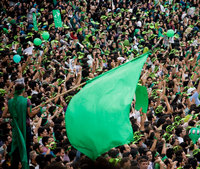Historians will eventually gain a fuller understanding of the forces that propelled the 2011 Arab Rebellion and of the changes that made decades of pent-up anti-government rage explode at precisely this moment. But just two months into the still-spreading uprising, we already know some of the important factors motivating protesters. We have also seen the range of responses the protests have elicited from the various Middle Eastern governments facing mass calls for the end of their entrenched regimes. What we have learned so far suggests that the revolution, like a wildfire on wind-whipped dry brush, will continue to spread. And just as flames leap over a highway, it will in all likelihood make the jump across the Persian Gulf into Iran.
But demands for change in the Islamic Republic cannot play out in the relatively peaceful way revolutions in Egypt and Tunisia unfolded. Instead, a sustained anti-regime uprising in Iran is likely to bring a very harsh crackdown, much like the one in Libya. The unique characteristics of Iran make for an even greater potential for furious violence.
Until now, the protests have remained confined to Arab countries of the Greater Middle East, meaning southwest Asia and North Africa. Each of the countries experiencing anti-government protests has distinctive traits, including different tribal, religious, economic, political and social makeups.

